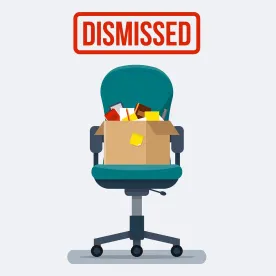When an employee experiences discrimination or retaliation at work it often takes the form of significant action, such as a termination, demotion, or suspension, all of which clearly represent an “adverse employment action” under relevant anti-discrimination and retaliation laws. But many times the retaliation and discrimination take subtler forms including a “death by a thousand cuts” approach. The question then becomes, was this conduct sufficiently concrete to meet the legal definition of employment discrimination or whistleblower retaliation?
Legal standards for proving employment discrimination and whistleblower retaliation
To establish a prima facie case of employment discrimination based on intentional discrimination an employee must show that they:
-
are a member of a protected class,
-
suffered an adverse employment action,
-
met their employer’s legitimate expectations at the time of the adverse employment action, and
-
were treated differently from similarly situated employees outside their protected class.
If these elements are met then the employer must articulate a non-discriminatory reason for the adverse employment action. If an employer does so, then the employee has to prove by a preponderance of the evidence that the employer’s articulated reason is a mere pretext/ excuse for discrimination.
Similarly, in a whistleblower retaliation case (for example under the Sarbanes Oxley Act of 2002 (SOX)), the employee must show:
-
they engaged in protected activity,
-
the employer knew they engaged in the protected activity,
-
they suffered an adverse employment action, and
-
the protected activity was a “contributing factor” in the adverse employment action
If the whistleblower makes this showing by a preponderance of the evidence, then the employer must prove by “clear and convincing evidence” that it would have taken the same adverse employment action even if the employee had not engaged in protected activity.
What counts as an “adverse employment action?”
Beyond clear examples of an adverse employment action, like being fired, suspended, or having your pay cut, it gets murky about what other actions rise to this level. Indeed, federal courts around the country have come to different answers based on similar facts. Courts arrive at various conclusions about the adverse employment action question based on whether the claim involves employment discrimination, on the one hand, or retaliation, on the other hand. And this question of whether an employer’s action rises to the level of an adverse employment action can make or break your employment discrimination or retaliation case.
Title VII employment discrimination cases
Title VII of the 1964 Civil Rights Act makes it unlawful for an employer to discriminate based on protected characteristics (for example, race, gender, religion, etc.) “with respect to [an individual’s] compensation, terms, conditions, or privileges of employment.” 42 U.S.C. 2000e-2(a)(1). The statutory language in Title VII does not mention “adverse employment action.” Instead, this concept took hold in various federal cases interpreting Title VII.
The Equal Employment Opportunity Commission, which enforces Title VII, has clarified that “adverse employment actions” include, but are not limited to:
-
Hiring
-
Firing
-
Failure to promote
-
Pay reduction
-
Demotion
Yet certain federal courts have interpreted Title VII to also require that the adverse employment action at issue must result in a “materially adverse consequence.” See, e.g., Ortiz-Diaz v. United States Dep’t of Hous. & Urban Dev., 867 F.3d 70, 74 (D.C. Cir. 2017). Under this approach, a lateral transfer that involves no economic loss would not rise to the level of an adverse employment action. Notably, the full D.C. Circuit Court of Appeals is currently reviewing this issue and both the EEOC and the U.S. Department of Justice Civil Rights Division have submitted amicus briefs in support of a broader interpretation of adverse employment action. By contrast, the U.S. Court of Appeals for the Fifth Circuit, which covers Texas, Louisiana, and Mississippi, finds that adverse employment actions cover only ultimate employment decisions like hiring, firing, and setting compensation. Peterson v. Linear Controls, Inc., 757 F.App’x. 370, 373 (5th Cir. 2019). Given the disagreement among the various federal courts of appeal, the Supreme Court may be poised to weigh in on this soon.
Sarbanes-Oxley (SOX) and related whistleblower claims as well as Title VII retaliation cases
In the whistleblower and Title VII retaliation context, courts review the adverse employment action issue through a slightly different lens. Indeed, the Supreme Court has ruled that a broader range of actions can be considered an “adverse action” in the retaliation context versus the discrimination context. For example, unlike in a discrimination case, the “scope of the anti-retaliation provision extends beyond workplace-related or employment-related retaliatory acts and harm.” Burlington Northern and Santa Fe Ry. Co. v. White, 548 U.S. 53, 67 (2006).
As with Title VII discrimination cases, in SOX and Title VII retaliation cases, the usual actions such as termination, demotion, and suspension count as retaliatory acts. But under Title VII and SOX retaliation cases, adverse actions also include any conduct that could “dissuade a reasonable worker from making or supporting” a discrimination or whistleblower complaint. Examples of this broader definition of adverse action include, “outing” a whistleblower by disclosing their identity, Halliburton, Inc. v. Admin. Review Bd., 771 F.3d 254 (5th Cir. 2014), and “blacklisting” of a former employee. 29 C.F.R. 1980.102(a).
Key Takeaways
It’s impossible to win an employment discrimination and/or retaliation case unless you can prove to a court that you have suffered an adverse employment action. Here are some points to keep in mind:
-
In a Title VII retaliation or SOX (and related whistleblower laws) retaliation claim, the definition of what constitutes an “adverse employment action” is broader than in a Title VII discrimination claim.
-
This broader definition in retaliation cases can include actions taken against former employees
-
Whether particular conduct rises to the level of an “adverse employment action” can depend on what state your lawsuit is filed in given the different interpretations of this phrase among the various federal courts of appeal.
-
The phrase “adverse employment action” is not found within Title VII’s statutory text; rather, it is a court-created concept.




 />i
/>i

